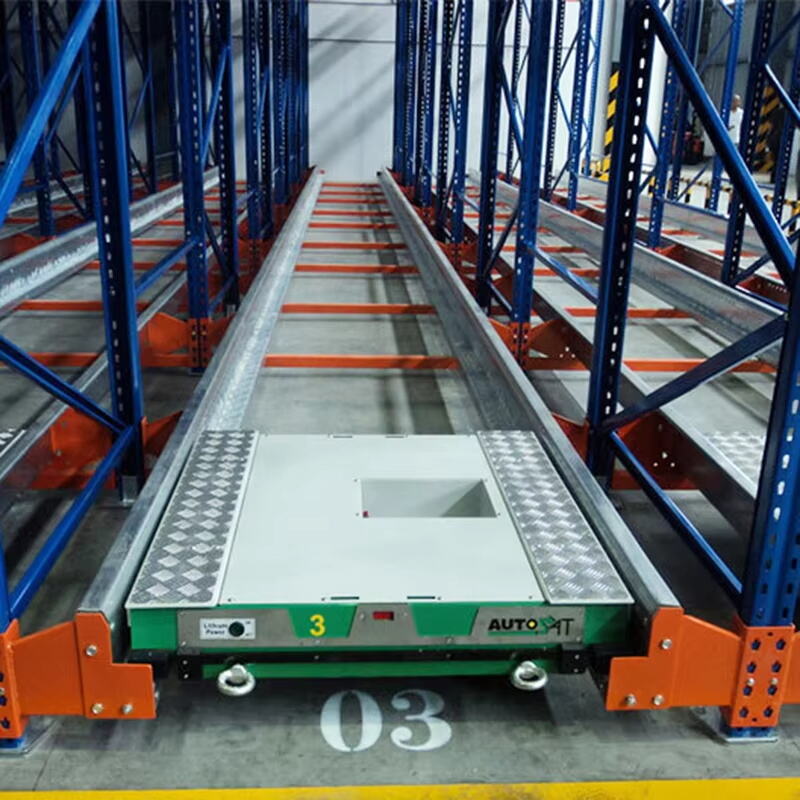চীনের শাটল সিস্টেমে সংরক্ষণের চ্যালেঞ্জ বোঝা
চীনা যোগাযোগে প্রধান সংরক্ষণ সমস্যার বিষয়সমূহ
চীনের বিভিন্ন প্রান্তে লজিস্টিক্স অপারেটরদের সংগ্রহস্থলের ব্যাপারে বড় ধরনের সমস্যার মুখোমুখি হতে হচ্ছে। ভিড়, অকার্যকর কার্যক্রম এবং আকাশছোঁয়া খরচের মতো সমস্যা এই শিল্পকে কালো মেঘের মতো ঢেকে রেখেছে। দেশের সর্বত্র ই-কমার্সের বিস্ফোরণের ফলে ভালো সংগ্রহস্থলের চাহিদা ব্যাপকভাবে বেড়েছে। চীনা লজিস্টিক্স ইনফরমেশন সেন্টারের একটি সম্প্রতি প্রকাশিত গবেষণা থেকে আন্দাজ করা হয়েছে যে 2025 সালের মধ্যে অনলাইন খুচরো বিক্রি 6.5 ট্রিলিয়ন ইয়ুয়ানের কাছাকাছি হতে পারে, যা বিদ্যমান লজিস্টিক্স ব্যবস্থার ওপর চাপ বাড়িয়ে দিচ্ছে। বেইজিং এবং শাংহাইয়ের মতো শহরগুলি বিশেষ চ্যালেঞ্জ হিসেবে দেখা দিয়েছে কারণ এগুলি অত্যন্ত ভিড় করা। এই মেগাসিটিগুলিতে জমির অভাব এবং ভূসম্পত্তির দাম আকাশছোঁয়া থাকায় গুদাম তৈরির জন্য জায়গা খুঁজে পাওয়া প্রায় অসম্ভব। এটি নতুন সংগ্রহস্থল নির্মাণকে অত্যন্ত কঠিন করে তুলছে, খরচ বাড়িয়ে দিচ্ছে এবং বৃদ্ধি পাওয়া ক্রেতার চাহিদা মেটাতে ব্যবসাগুলির জন্য বিভিন্ন ধরনের লজিস্টিক্স সমস্যা তৈরি করছে।
পরিচালন দক্ষতা পরিমাপে সীমিত স্থানের প্রভাব
যখন গুদামগুলি পণ্য সংরক্ষণের জন্য জায়গা শেষ হয়ে যায়, তখন অর্ডারগুলি প্রক্রিয়া এবং পাঠানোর গতি নষ্ট করে। চীনের যোগান চেইন কেন্দ্রগুলিতে কী ঘটছে তা দেখলে এই সমস্যাটি স্পষ্ট হয়ে ওঠে। জায়গার সংকট অপারেশনগুলির জন্য বিভিন্ন ধরনের সমস্যা সৃষ্টি করে, যেখানে প্রক্রিয়াকরণের সময় ধীর হয়ে যায় এবং দেরিতে ডেলিভারি দৈনন্দিন ঘটনা হয়ে ওঠে। এই সমস্যা সমাধানের জন্য, অনেক কোম্পানি বিভিন্ন পদ্ধতি চেষ্টা করে। কিছু কোম্পানি তাদের গুদামের জায়গা পুনরায় ডিজাইন করে এবং অন্যরা ছাদের দিকে বাড়িয়ে দেওয়া শেলফিং সিস্টেম ব্যবহার করে। কিন্তু এই সমাধানগুলির প্রত্যেকটির জন্য খরচ থাকে। শুধুমাত্র প্রযুক্তি বিনিয়োগ অনেক বেশি খরচ হতে পারে, নতুন করে সম্পূর্ণ যোগান চেইন প্রক্রিয়াগুলি পুনর্গঠন করার খরচও পড়ে। যদিও ব্যবসাগুলি জায়গার সমস্যার সমাধানের জন্য নতুন উপায় খুঁজে বেড়ায়, কিন্তু মূল বিষয়টি সহজ থেকে যায়: যথেষ্ট পরিমাণে সংরক্ষণের জায়গা খুঁজে পাওয়া লজিস্টিক শিল্পে দৈনিক কার্যকারিতা প্রভাবিত করে এমন বৃহত্তম চ্যালেঞ্জগুলির মধ্যে একটি হয়ে থাকে।
সংরক্ষণ স্থান অপটিমাইজেশনের জন্য উন্নত প্রযুক্তি
আইওটি-চালিত শাটল র্যাক সিস্টেম
ইন্টারনেট অফ থিংস আমাদের স্টোরেজ স্পেসগুলি অপটিমাইজ করার পদ্ধতিকে পরিবর্তন করছে কারণ এটি সেইসব অটোমেটেড শাটল র্যাক সিস্টেমগুলির সময়োপযোগী নিগরানীর মাধ্যমে। লজিস্টিক ম্যানেজাররা এখন তাদের মজুতের উপর আরও ভালো নিয়ন্ত্রণ পাচ্ছেন এবং পাওয়া যায় এমন স্থানের সদ্ব্যবহার করছেন কারণ এই আইওটি সেন্সরগুলি তাদের কাছে গুদামজাত করা স্থানগুলির ভিতরে কী হচ্ছে তার নিরন্তর আপডেট পাঠায়। বিভিন্ন খাতের অনেক ব্যবসা প্রতিষ্ঠানের কাছে এই প্রযুক্তি গ্রহণের পর দক্ষতার ব্যাপক উন্নতি দেখা গেছে, যা চীনের বৃদ্ধিশীল লজিস্টিক শিল্পের জন্যও আশাপ্রদ। সম্প্রতি প্রকাশিত একটি প্রতিবেদন দেখায় যে যেসব প্রস্তুতকারক আইওটি সমাধান প্রয়োগ করেছেন তাদের মোট দক্ষতায় প্রায় 25 শতাংশ উন্নতি হয়েছে। এই ধরনের ফলাফল আশা জাগায় যে একই নীতি সংরক্ষণ ব্যবস্থায় প্রয়োগ করলে অনুরূপ সুবিধাগুলি পাওয়া যেতে পারে। ইতিমধ্যে চীনের বেশ কয়েকটি প্রধান প্রতিষ্ঠান নবায়নযোগ্য আইওটি চালিত শাটল সিস্টেম বিকাশে অগ্রণী ভূমিকা পালন করছে, তাদের লজিস্টিক অপারেশনগুলি থেকে প্রতিটি কার্যকরী ক্ষমতা বের করে আনার জন্য নতুন পদ্ধতি চেষ্টা করে যাচ্ছে।
অটোমেটেড রিট্রিভাল সমাধান
অটোমেটেড স্টোরেজ এবং রিট্রিভাল সিস্টেম (AS/RS)-এ সাম্প্রতিক উন্নতির ফলে গুদামগুলি আগের চেয়ে অনেক বেশি দ্রুত এবং নির্ভুলভাবে চলছে। এই সিস্টেমগুলিকে কী এত কার্যকর করে তুলছে? এগুলি পণ্যগুলির খোঁজে সময় কমানোর পাশাপাশি মূল্যবান মানব ঘন্টাও বাঁচাচ্ছে। শিল্প প্রতিবেদন অনুসারে, যেসব প্রতিষ্ঠান AS/RS-এ স্যুইচ করে, তাদের পিকিং নির্ভুলতা সাধারণত 99% এর বেশি হয়ে থাকে, কখনও কখনও প্রায় নিখুঁত স্তরে পৌঁছায়। খরচের দিকে তাকালে, পুরানো ধরনের ম্যানুয়াল পদ্ধতির তুলনায় অটোমেটেড শাটল সিস্টেমের ক্ষেত্রে হিসাবটি এখনও ভালো হয়ে থাকে। অবশ্যই, শুরু করার জন্য প্রচুর পরিমাণে প্রাথমিক বিনিয়োগের প্রয়োজন হয়, কিন্তু বেশিরভাগ ব্যবসাই সময়ের সাথে সাথে কম কর্মচারী নিয়োগের প্রয়োজন এবং উচ্চ উৎপাদন পরিমাণের কারণে অর্থ সাশ্রয় করতে পারে। এই ধরনের বিকল্পগুলি মূল্যায়ন করে চীনা যোগান ব্যবস্থার পরিচালকরা প্রায়শই দুটি প্রধান সুবিধা উল্লেখ করেন: ইনভেন্টরি পরীক্ষার সময় কম ভুল এবং গ্রাহকদের অর্ডারের দ্রুত প্রতিক্রিয়া সময়। এই বাস্তব সুবিধাগুলি সমগ্র সরবরাহ চেইন অপারেশনে স্পষ্ট উন্নতিতে পরিণত হয়।
নমনীয় স্থান ব্যবহারের জন্য মডুলার সংরক্ষণ ডিজাইন
স্কেলযোগ্য শাটল র্যাক কোনফিগারেশন
স্কেলযোগ্য শাটল র্যাক সিস্টেমগুলি সংরক্ষণের চাহিদা পরিবর্তনের সাথে খাপ খাইয়ে নেওয়ার ক্ষেত্রে বিশেষ ভূমিকা পালন করে, বিশেষ করে যেহেতু বর্তমানে অনেক ব্যবসায়িক প্রতিষ্ঠানের মজুত পরিমাণের পরিবর্তনশীলতা নিয়ে সংশ্লিষ্ট সমস্যা রয়েছে। এই ধরনের ব্যবস্থার সুবিধা হল যে গুদামগুলি স্থান নষ্ট না করেই সংরক্ষণের পরিসর বাড়াতে বা কমাতে পারে, যার ফলে প্রতিটি বর্গফুটের সদ্ব্যবহার হয়। চীনের কথাই ধরুন, যেখানে প্রস্তুতকারকরা মজুতের পরিমাণ পরিবর্তনের সাথে সাথে স্কেলযোগ্য ডিজাইন ব্যবহার করে তাদের সংরক্ষণ ব্যবস্থা সামাঞ্জস্য করে থাকেন, যার ফলে কার্যক্রম নিরবচ্ছিন্ন রাখা যায় এবং অপ্রীতিকর সময়ের স্থগিতাবস্থা এড়ানো যায়। আরও ভাল পরিচালনার জন্য পারম্পরিক স্থির ব্যবস্থার পরিবর্তে মডুলার সংরক্ষণ বিকল্পগুলি ব্যবহার করা দীর্ঘমেয়াদী খরচ কমায় এবং দৈনন্দিন কাজকর্ম আরও মসৃণ করে তোলে। যখন কোনও প্রতিষ্ঠানকে বড় ধরনের পুনর্গঠনের জন্য সবকিছু ভেঙে ফেলতে হয় না, তখন তারা পুনর্বিন্যাসের বিষয়ে কম চিন্তা করে এবং কার্যক্রমের সুষম সমন্বয়ে বেশি মনোযোগ দেয়। শ্রম খরচ এবং রক্ষণাবেক্ষণ খরচও কমে যায়, যার ফলে সরবরাহ চেইনটি মোটামুটি আরও ভালভাবে কাজ করে।
বহু-স্তর উল্লম্ব সংরক্ষণ কৌশল
মাল্টি-স্তরযুক্ত ভার্টিক্যাল স্টোরেজ সমাধানগুলি ব্যবসাগুলিকে ইনভেন্টরির প্রবেশাধিকার না কমিয়েই সংকীর্ণ স্থানগুলি থেকে আরও বেশি কিছু আদায় করতে সাহায্য করে। চীনের অসংখ্য গুদামজাত করা পন্যের ভাণ্ডারে এই পদ্ধতি গ্রহণ করেছে, যা শ্রমিকদের আরও উঁচুতে জিনিসপত্র সাজানোর এবং প্রতিটি বর্গমিটারকে আরও ভালোভাবে ব্যবহার করার সুযোগ করে দিয়েছে। উদাহরণ হিসাবে শাংহাইয়ের অটো পার্টস প্রস্তুতকারকদের কথা বলা যায়, তারা স্তরযুক্ত সংরক্ষণ ব্যবস্থায় আসার পর থেকে মেঝের প্রয়োজনীয়তা অর্ধেক কমিয়ে দিয়েছে এবং এখন তাদের কর্মীরা উপাদানগুলি অনেক দ্রুত হাত করতে পারছে। অবশ্যই এই স্তরযুক্ত ব্যবস্থায় যাওয়ার সময় কিছু প্রতিবন্ধকতা দেখা দেয়। প্রাথমিক বিনিয়োগ অনেক বেশি এবং কর্মচারীদের প্রত্যেকের কিছু সময় নিয়ে বুঝে নিতে হয় কীভাবে সবকিছু একসাথে কাজ করে। স্মার্ট কোম্পানিগুলি এটির মোকাবিলা করে প্রতিটি স্তরে কী কোথায় রয়েছে তা ট্র্যাক করার জন্য ভালো সফটওয়্যার এনে এবং নিয়মিত প্রশিক্ষণ চালিয়ে যেতে থাকে যতক্ষণ না সকলে নতুন কাজের ধরনের সঙ্গে স্বাচ্ছন্দ্য বোধ করে। অধিকাংশের কাছেই এটি কয়েক মাসের মধ্যে লাভজনক প্রমাণিত হয়, কারণ কার্যনির্বাহ আরও মসৃণ হয়ে ওঠে।
কেস স্টাডিজ: চীনা প্রতিষ্ঠানগুলির সাফল্যের গল্প
শাংহাইয়ে পোর্ট লজিস্টিকস অপ্টিমাইজেশন
সম্প্রতি শ্যাংহাইয়ের বন্দর ব্যবস্থা ভালো সংরক্ষণ সমাধানের মাধ্যমে লজিস্টিক্স উন্নতিতে কয়েকটি অসামান্য অগ্রগতি অর্জন করেছে। সেখানে একটি প্রধান বন্দর তাদের সুবিধাগুলি পরিচালনার পদ্ধতি সম্পূর্ণ পুনর্গঠন করেছে, যা উপলব্ধ স্থান এবং সম্পদের বুদ্ধিদীপ্ত ব্যবহার করার সুযোগ করে দিয়েছে। আসলে ফলাফলগুলি বেশ চমকপ্রদ হয়েছে - এখন জাহাজগুলি অপেক্ষা করে প্রায় 30% কম সময় এবং সেখানকার পরিচালন খরচও অবশ্যই কম হয়েছে। তারা কিছু উন্নত মালামাল ট্র্যাকিং সিস্টেম চালু করেছে যা সবকিছু মসৃণভাবে চালাতে এবং কন্টেইনারগুলি দ্রুত সরাতে সাহায্য করেছে। এটি যা দেখায় তা হল চীনের অন্যান্য বন্দরগুলি এই পদ্ধতি থেকে শেখা পারে। যখন বন্দরগুলি প্রযুক্তিগত আপগ্রেড এবং বুদ্ধিদীপ্ত স্থান পরিকল্পনার দিকে মনোযোগ দেয়, তখন তারা সাধারণত অর্থ সাশ্রয় করতে পারে এবং আরও ভালো পরিষেবা প্রদান করতে পারে। কয়েকটি ছোট উপকূলীয় শহর ইতিমধ্যে ভালো সাড়া পেয়ে একই ধরনের কৌশল অনুসরণ শুরু করেছে।
শেনজেনে ই-কমার্স ওয়্যারহাউস নবায়ন
শেনজেন শহরটি দীর্ঘদিন ধরেই টেক খাতে নতুন নতুন উদ্ভাবনের ক্ষেত্রে সীমারেখা ছাড়িয়ে যাওয়ার জন্য পরিচিত এবং সম্প্রতি স্থানীয় একটি ই-কমার্স প্রতিষ্ঠান তাদের স্মার্ট স্টোরেজ পদ্ধতির মাধ্যমে গুদামজাতকরণ ব্যবস্থায় ঢেউ তুলেছে। তারা স্বয়ংক্রিয় সংরক্ষণ ও পুনরুদ্ধার ব্যবস্থা প্রয়োগ করেছে, যা সাধারণত AS/RS নামে পরিচিত, যা প্রকৃতপক্ষে কাজের গতি বাড়িয়ে দিয়েছে। তাদের অর্ডার পূরণের হার দ্রুত বৃদ্ধি পায়, ডেলিভারিতে প্রায় 95% নির্ভুলতা ছুঁয়েছে, যা ক্রেতাদের খুশি রাখে এবং আরও বেশি ক্রয়ের জন্য আকৃষ্ট করে। এই ধরনের প্রযুক্তিগত আপগ্রেডগুলি কেবল চকচকে প্রদর্শনী নয়, এগুলি দৈনন্দিন কার্যক্রমে প্রকৃত পার্থক্য তৈরি করে। রোবটিক্স এবং কৃত্রিম বুদ্ধিমত্তা নিয়ে আসার মাধ্যমে, এই প্রতিষ্ঠানটি তাদের মজুত নিয়ন্ত্রণে অনেক বেশি নিয়ন্ত্রণ রাখতে সক্ষম হয়েছে এবং সম্পূর্ণ অর্ডার প্রক্রিয়াকরণ স্পিড বাড়িয়েছে। ফলস্বরূপ, তারা আগের তুলনায় দ্বিগুণ অর্ডার সম্পন্ন করতে সক্ষম হয়েছে অনায়াসে। এই ব্যবসায়ের অর্জনগুলি দেখলে বোঝা যায় যে প্রযুক্তি কীভাবে অনলাইন খুচরা বিক্রেতাদের জন্য মসৃণ পরিচালনার সাথে সাথে ক্রেতাদের কাছে শীর্ষ সেবা পৌঁছানোর ক্ষেত্রে কার্যকরী হতে পারে।

চীনের স্টোরেজ অপ্টিমাইজেশন ল্যান্ডস্কেপে ভবিষ্যতের প্রবণতা
AI-পাওয়ারড প্রেডিকটিভ স্পেস ম্যানেজমেন্ট
আজকাল স্পেস প্রেডিকশন ম্যানেজ করার জন্য কৃত্রিম বুদ্ধিমত্তা খুব গুরুত্বপূর্ণ হয়ে উঠছে, সংরক্ষণ অপ্টিমাইজেশনকে আগের চেয়ে অনেক বেশি ভালো করে তুলছে। অনেক ব্যবসা পূর্বনির্ধারিত সংরক্ষণের প্রয়োজনীয়তা বোঝার জন্য, খালি জায়গা কমানোর জন্য এবং সাধারণত তাদের যোগাযোগ পরিচালনা মসৃণ করার জন্য এআই সরঞ্জাম বাস্তবায়ন করতে শুরু করেছে। এই স্মার্ট সিস্টেমগুলি দেশের বিভিন্ন গুদাম থেকে বিপুল পরিমাণ তথ্য পর্যালোচনা করে, তারপর আগামী মাস বা এমনকি পরবর্তী ত্রৈমাসিকে কী ঘটতে পারে তা ভবিষ্যদ্বাণী করে। যোগাযোগ ব্যবস্থাপকরা তখন অনুমানের পরিবর্তে প্রকৃত প্যাটার্নের উপর ভিত্তি করে তাদের মজুত কোথায় রাখা উচিত তা সিদ্ধান্ত নিতে পারেন। অধিকাংশ বিশেষজ্ঞ মনে করেন যে আগামী কয়েক বছরে এআই গ্রহণে বৃদ্ধি হবে। কিছু প্রতিবেদনে প্রস্তাব করা হয়েছে যে 2029 সালের মধ্যে প্রায় তিন-চতুর্থাংশ যোগাযোগ প্রতিষ্ঠান গুদাম ব্যবস্থাপনার মধ্যে কোনও না কোনও আকারে এআই ব্যবহার করছে। সাম্প্রতিক সময়ে এআই অ্যালগরিদমগুলি কতটা উন্নত হয়েছে এবং সরবরাহ চেইনের মধ্যে আইওটি সেন্সর এবং অন্যান্য ট্র্যাকিং ডিভাইসগুলি থেকে পাওয়া নতুন ডেটা স্ট্রিমগুলি বিবেচনা করলে এই দ্রুত প্রসারণটি যৌক্তিক।
স্থিতিশীল ম্যাটেরিয়াল হ্যান্ডлин্গ প্র্যাকটিস
সংরক্ষণ এবং যোগাযোগে স্থিতিশীলতা আজকাল চীনে গুরুত্ব পাচ্ছে। সরকারের কঠোর নিয়ম এবং গ্রাহকদের চাহিদা ব্যবসাগুলিকে তাদের পরিচালন পদ্ধতি আরও পরিবেশবান্ধব করতে বাধ্য করছে। অনেক গুদামে এখন কম শক্তি খরচকারী সরঞ্জাম ব্যবহার হচ্ছে এবং পুনর্ব্যবহারযোগ্য উপকরণ দিয়ে তৈরি প্যাকেজিংয়ে পরিবর্তন করা হচ্ছে। যখন কোম্পানিগুলি উপকরণ স্থিতিশীলভাবে পরিচালনা করে, তখন পরিবেশগত সমস্যাগুলি মোকাবেলা করা হয় এবং অর্থও বাঁচে। কয়েকটি গবেষণা থেকে দেখা গেছে যে স্থিতিশীল পদ্ধতিতে কাজ করা কোম্পানিগুলি প্রায় 20 শতাংশ পর্যন্ত খরচ কমাতে পারে এবং নৈতিকতা সম্পর্কে সচেতন গ্রাহকদের কাছে তাদের ছবি আরও ভালো হয়। শাংহাই এবং বেইজিংয়ের মতো বড় শহরগুলিতে যা ঘটছে তা দেখলে পরিষ্কার হয়ে যায় যে এটি কেবল একটি সাময়িক প্রবণতা নয়, বরং চীনে যোগাযোগ খাতের ক্রমবিকাশের অংশ।
প্রায়শই জিজ্ঞাসিত প্রশ্নাবলী
চীনের যোগাযোগ খণ্ডে প্রধান সংরক্ষণ চ্যালেঞ্জগুলি কী কী? প্রধান চ্যালেঞ্জগুলি হল ভিড়, অকার্যকরতা এবং উচ্চ কার্যনির্বাহী খরচ, যা শহরগুলির ভৌগোলিক সীমাবদ্ধতার কারণে আরও বেড়েছে।
সীমিত সংরক্ষণ স্থান কার্যনির্বাহী দক্ষতাকে কীভাবে প্রভাবিত করে? সীমিত স্থানের কারণে প্রতি ঘন্টায় উৎপাদন হ্রাস পায় এবং দেরিতে ডেলিভারি হয়, যার ফলে কোম্পানিগুলি ব্যয়বহুল কৌশলগুলি অনুসন্ধান করছে, যেমন গুদামের লেআউটগুলি অপটিমাইজ করা।
কোন প্রযুক্তি সংগ্রহস্থল অপটিমাইজেশন উন্নত করছে? আইওটি এবং এআই প্রযুক্তিগুলি উল্লেখযোগ্য, সময়ানুবর্তী নিগরানি এবং ভবিষ্যদ্বাণীমূলক স্থান ব্যবস্থাপনা প্রদান করে যা দক্ষতা বাড়াতে সাহায্য করে।
সংগ্রহস্থলে স্বয়ংক্রিয় পদ্ধতির ভূমিকা কী? স্বয়ংক্রিয় সংগ্রহ ও পুনরুদ্ধার পদ্ধতিগুলি প্রক্রিয়াগুলিকে স্ট্রিমলাইন করে, পিকিং নির্ভুলতা বাড়ায় এবং শ্রম খরচ কমায়।
চীনে সংগ্রহস্থল অপটিমাইজেশনের ভবিষ্যতের ক্ষেত্রে কোন প্রবণতাগুলি আকার দিচ্ছে? এআই-চালিত ভবিষ্যদ্বাণীমূলক ব্যবস্থাপনা এবং নিঃসরণযোগ্য উপকরণ পরিচালনার অনুশীলনগুলি হল খণ্ডে ভবিষ্যতের অগ্রগতির পিছনে চালিত প্রধান প্রবণতাগুলি।

